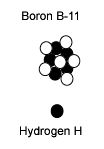Hydrogen-Boron vs. Deuterium-Tritium

- Conventional Approach - Deuterium-Tritium Fuel
- creates heat that is then turned into electricity, has
radioactivity issues.
- The Clean Alternative - Hydrogen Boron Fuel
The Conventional Approach - Deuterium-Tritium Fuel
Most fusion research today is focused on fusing deuterium and tritium. Deuterium has one proton and one neutron. Tritium has one proton and two neutrons. When they come together there are two protons and three neutrons. This unstable configuration then splits into a helium atom (two protons and two neutrons) and a high energy neutron. These neutrons create heat and radioactive materials just as in a fission reactor.

Deuterium and helium are not radioactive and occur in nature. Tritium, however, is radioactive and does not occur in nature. It must be created in the reactor by using neutrons. So deuterium-tritium fusion still has two of the disadvantages of nuclear fission:
* Some of the fuel (tritium) is radioactive. (Note, Tritium has
other drawbacks as well: It is in short supply and it can be used in
nuclear weapons.)
* The high energy neutrons can take ordinary materials in the reactor
building and make them radioactive.
Deuterium-tritium fusion would produce much less radioactive waste than fission, but radioactive waste can be avoided altogether by choosing a better fuel.
The Clean Alternative - Hydrogen Boron Fuel
Boron-11 is an atom that contains five protons and six neutrons. Boron exists naturally as 19.9% 10B isotope and 80.1% 11B isotope. Boron-11 can fuse with a hydrogen atom (one proton, no neutrons.) This makes six protons and six neutrons which is exactly enough for three helium atoms with no left over neutrons. The helium atoms then fly off at high speeds carrying the fusion energy. So hydrogen-boron fusion can create energy without releasing neutrons.

Boron-11 is a common element that exists in the earth’s crust and seawater. You may even have some in your house if you own a box of Borax. Hydrogen is the most common element in the universe and is even part of water as demonstrated by the formula H2O. Helium is the second most common element in the universe and is what makes children’s balloons and blimps float. None of these materials is radioactive.
Hydrogen-Boron process eliminates radioactive waste
So, when a boron-11 atom fuses with a hydrogen atom the result is three helium atoms and energy, but no radioactive waste:
* The fuel (boron and hydrogen) is not radioactive.
* The reaction product (helium) is not radioactive.
* The reaction releases no neutrons.
It is true that the hydrogen-boron reaction releases no neutrons, but as fusion progresses a greater number of helium atoms are created and occasionally a boron atom will fuse with a helium instead of a hydrogen. This produces a (non-radioactive) nitrogen atom and a neutron. However, this reaction releases very little energy and so the neutron is not the same as the high energy neutrons produced by fission or deuterium-tritium fusion. These low-energy neutrons can create a small amount of short-lived radioactive materials, but these materials decay so quickly that it would be safe to enter a room containing a focus fusion device seconds after it is turned off.
Additionally, at such high temperatures electrons do emit x-rays. These are exactly the same as the x-rays produced in your doctor’s office, or in the baggage scanning machines at the airport. X-rays can be dangerous if people are exposed to large doses, but they can be stopped by lead shielding. Our society has extensive experience using x-rays safely. Together these low energy neutrons, x-rays, and short-lived radioactive materials disappear quickly and do not generate radioactive waste.
Hydrogen-Boron process generates electricity directly
As noted, a conventional fusion reactor using deuterium-tritium fuel is designed to produce neutrons that create heat. This heat energy would require expensive turbines and generators to form electricity. In contrast to this, A focus fusion reactor using hydrogen-boron fuel would produce electricity directly.
The energy from fusion reactions is released mainly in the form of a high energy helium nuclei. In focus fusion reactors, these nuclei come out in the form of a tight pulsed beam, in other hydrogen-boron reactor types, they would come out as a broader stream.
Since the nuclei are electrically charged, they already form an electric current. All that is needed is to capture this electric energy into an electric circuit. In focus fusion reactors, this can be done by allowing the pulsed beam to generate electric currents in a series of coils as it passes through them.
This is much the same way that a transformer works, stepping electric power down from the high voltage of a transmission line to the low voltage used in homes and factories. Such an electrical transformation can be highly efficient, probably around 80-90%.
What is most important is that it is exceedingly cheap and compact. The whole apparatus of steam turbine and electrical generator are eliminated. The energy from the x-rays can also be converted directly into electricity in a compact, cheap way. So hydrogen-boron fuel could potentially cut the cost of electric generation by a factor of 100.
The Challenge: B-11 requires higher ignition temperatures
So why, you may wonder, are researchers spending so much time on deuterium-tritium fusion when hydrogen-boron has clear advantages? The reason is that deuterium-tritium fusion is easier to ignite. It requires temperatures of only 100 million Kelvin while hydrogen-boron fusion requires 1 billion Kelvin.
Unfortunately, many fusion researchers have spent their careers developing a device called the tokamak which cannot reach the temperatures required for hydrogen-boron fusion.
Rather than looking for new ideas, the fusion research establishment has decided that the radioactive waste produced by deuterium-tritium fusion is acceptable.
However, there is a device which can reach 1 billion Kelvin - the Focus Fusion device.
The article originally published at http://focusfusion.org